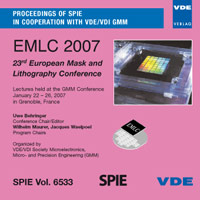Reticle Haze: An Industrial Approach
Conference: EMLC 2007 - 23rd European Mask and Lithography Conference
01/22/2007 - 01/26/2007 at Grenoble, France
Proceedings: EMLC 2007
Pages: 12Language: englishTyp: PDF
Personal VDE Members are entitled to a 10% discount on this title
Authors:
Gough, Stuart; Gérard, Xavier; Bichebois, Pascal; Roche, Agnès; Sundermann, Frank; Guyader, Véronique; Bièron, Yann; Galvier, Jean; Nicoleau, Serge (STMicroelectronics - Alliance Crolles2 Operations 850, rue Jean Monnet, 38926, Crolles, France)
Abstract:
Crystal growth on advanced reticles is currently a world wide industrial problem in high end semiconductor production environment, crystals are mainly found on reticles that use high energy photons at 193nm wavelength. The most common crystals to be found on masks are ammonium sulphate, a combination of sulphate, from maskshop residues after clean, pellicle materials and storage conditions and amines from clean room, tool and storage environments. High energy photons act as a catalyst to form crystals on both the pattern side as well as the backglass surface. After a number of exposures crystals can grow in size and eventually become printable. In order to detect HAZE before critical dimensions have been reached suitable detection methods need to be implemented to ensure image integrity. These detection methods are different and complementary depending on the surface to be inspected. Once crystals have started growing, the only method to regain mask quality is to clean the mask at the manufacturers site. This brings with it several undesirable situations, not only is the mask unavailable for production but the cleaning of a mask leads to a potential risk of damaging the mask especially for sub resolution patterns such as scatter bars and phase and transmission changes for eaPSM (Embedded Attenuated Phase Shift Mask) masks. This paper will discuss the initial haze issues seen in a 300mm wafer fab and actions put in place to address the problem. An explanation of results gained from haze reduction actions implemented in a wafer fab will be given. Haze seen by reticle inspection and surface analysis tools can be characterised by typical contamination patterns. These signatures appear after a certain number of wafers exposed depending on several reticle variables such as transmission, Binary, eaPSM, Pellicle. Details will be given of how reticles are managed to ensure minimum impact to a production environment with an appropriate reticle control plan. AMC (Airborne Molecular Contamination) in wafer fab and equipment environment is a key factor for crystal growth. The type of filtration installed to reduce AMC and method of atmospheric monitoring for critical areas will be explained. Choice of reticle storage conditions and materials used for transport during the life of the reticle will be included. Improvements in maskshop cleaning processes, reticle materials and environmental control have lead to extended mask lifetime in the wafer fab of more than 20 times. The fundamental differences and relative monitoring will be described and gain from implemented actions will be presented.


